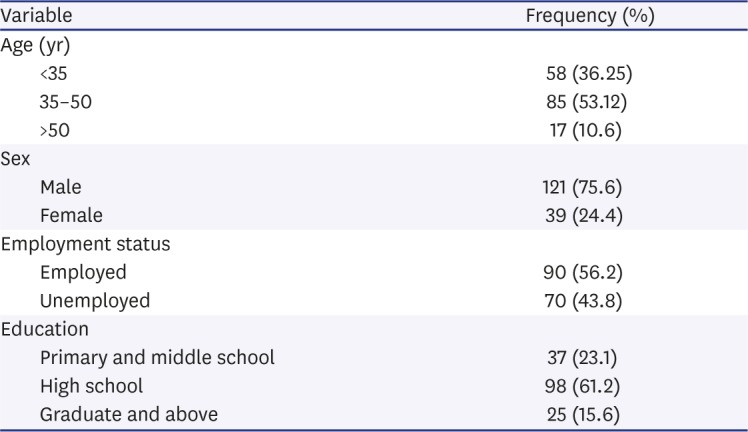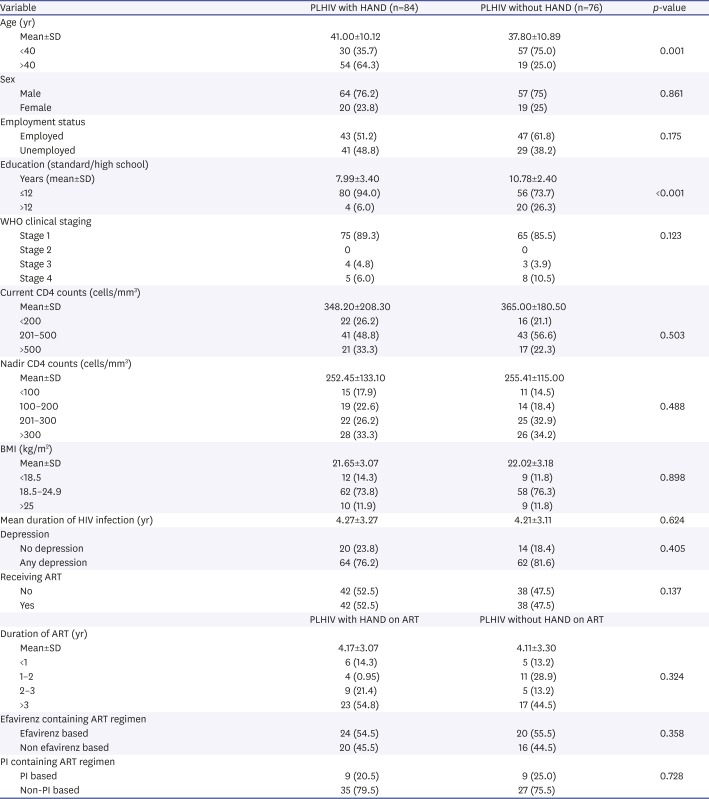1. Fauci AS, Lane HC. Human immunodeficiency virus disease: AIDS and related disorders. In : Longo DL, Kasper MD, Jameson JL, Fauci AS, Hauser SL, Loscalzo J, editors. Harrison's Principles of Internal Medicine. 18th ed. New York: McGraw-Hill Companies;2011. p. 1506–1587.
2. Antinori A, Arendt G, Becker JT, Brew BJ, Byrd DA, Cherner M, et al. Updated research nosology for HIV-associated neurocognitive disorders. Neurology. 2007; 69:1789–1799. PMID:
17914061.

3. Gisslén M, Price RW, Nilsson S. The definition of HIV-associated neurocognitive disorders: are we overestimating the real prevalence? BMC Infect Dis. 2011; 11:356. PMID:
22204557.

4. Valcour V, Paul R, Chiao S, Wendelken LA, Miller B. Screening for cognitive impairment in human immunodeficiency virus. Clin Infect Dis. 2011; 53:836–842. PMID:
21921226.

5. Hasbun R, Eraso J, Ramireddy S, Wainwright DA, Salazar L, Grimes R, et al. Screening for neurocognitive impairment in HIV individuals: the utility of the montreal cognitive assessment test. J AIDS Clin Res. 2012; 3:186. PMID:
23956944.

6. Mind Exchange Working Group. Assessment, diagnosis, and treatment of HIV-associated neurocognitive disorder: a consensus report of the mind exchange program. Clin Infect Dis. 2013; 56:1004–1017. PMID:
23175555.
7. British HIV Association. British HIV Association standards of care for people living with HIV 2018. Hertfordshire: British HIV Association;cited 2019 Dec 23. Available from:
https://www.bhiva.org/standards-of-care-2018.
9. Lawton MP, Brody EM. Assessment of older people: self-maintaining and instrumental activities of daily living. Gerontologist. 1969; 9:179–186. PMID:
5349366.

10. Kroenke K, Spitzer RL, Williams JB. The PHQ-9: validity of a brief depression severity measure. J Gen Intern Med. 2001; 16:606–613. PMID:
11556941.
11. Heaton RK, Clifford DB, Franklin DR Jr, Woods SP, Ake C, Vaida F, et al. HIV-associated neurocognitive disorders persist in the era of potent antiretroviral therapy: CHARTER Study. Neurology. 2010; 75:2087–2096. PMID:
21135382.

12. Deshpande AK, Patnaik MM. Nonopportunistic neurologic manifestations of the human immunodeficiency virus: an Indian study. J Int AIDS Soc. 2005; 7:2–4. PMID:
19825135.

13. Singh R, Kaur M, Arora D. Neurological complications in late-stage hospitalized patients with HIV disease. Ann Indian Acad Neurol. 2011; 14:172–177. PMID:
22028528.

14. Teja VD, Talasila SR, Vemu L. Neurologic manifestations of HIV infection: an Indian hospital-based study. AIDS Read. 2005; 15:139–143. PMID:
15786577.
15. Saini S, Barar KV. Assessment of neurocognitive functions in HIV/AIDS patients on HAART using the international HIV dementia scale. Int J Nutr Pharmacol Neurol Dis. 2014; 4:252–255.

16. Muniyandi K, Venkatesan J, Arutselvi T, Jayaseelan V. Study to assess the prevalence, nature and extent of cognitive impairment in people living with AIDS. Indian J Psychiatry. 2012; 54:149–153. PMID:
22988322.

17. Achappa B, Priyadarshni S, Madi D, Bhaskaran U, Ramapuram JT, Rao S, et al. Neurocognitive dysfunction among HIV positive patients using International HIV dementia scale. Asian J Med Sci. 2014; 5:61–64.

18. Simioni S, Cavassini M, Annoni JM, Rimbault Abraham A, Bourquin I, Schiffer V, et al. Cognitive dysfunction in HIV patients despite long-standing suppression of viremia. AIDS. 2010; 24:1243–1250. PMID:
19996937.

19. Vivithanaporn P, Heo G, Gamble J, Krentz HB, Hoke A, Gill MJ, et al. Neurologic disease burden in treated HIV/AIDS predicts survival: a population-based study. Neurology. 2010; 75:1150–1158. PMID:
20739646.

20. McArthur JC, Steiner J, Sacktor N, Nath A. Human immunodeficiency virus-associated neurocognitive disorders: mind the gap. Ann Neurol. 2010; 67:699–714. PMID:
20517932.
21. Yakasai AM, Gudaji MI, Muhammad H, Ibrahim A, Owolabi LF, Ibrahim DA, et al. Prevalence and correlates of HIV-associated neurocognitive disorders (HAND) in Northwestern Nigeria. Neurol Res Int. 2015; 2015:122–129.

22. Grant I, Franklin DR Jr, Deutsch R, Woods SP, Vaida F, Ellis RJ, et al. Asymptomatic HIV-associated neurocognitive impairment increases risk for symptomatic decline. Neurology. 2014; 82:2055–2062. PMID:
24814848.

23. McCutchan JA, Marquie-Beck JA, Fitzsimons CA, Letendre SL, Ellis RJ, Heaton RK, et al. Role of obesity, metabolic variables, and diabetes in HIV-associated neurocognitive disorder. Neurology. 2012; 78:485–492. PMID:
22330412.

24. Cross S, Önen N, Gase A, Overton ET, Ances BM. Identifying risk factors for HIV-associated neurocognitive disorders using the international HIV dementia scale. J Neuroimmune Pharmacol. 2013; 8:1114–1122. PMID:
24114509.

25. Troncoso FT, Conterno LO. Prevalence of neurocognitive disorders and depression in a Brazilian HIV population. Rev Soc Bras Med Trop. 2015; 48:390–398. PMID:
26312927.

26. Choi Y, Townend J, Vincent T, Zaidi I, Sarge-Njie R, Jaye A, et al. Neurologic manifestations of human immunodeficiency virus-2: dementia, myelopathy, and neuropathy in West Africa. J Neurovirol. 2011; 17:166–175. PMID:
21424866.

27. Chan LG, Kandiah N, Chua A. HIV-associated neurocognitive disorders (HAND) in a South Asian population - contextual application of the 2007 criteria. BMJ Open. 2012; 2:e000662.

28. Ku NS, Lee Y, Ahn JY, Song JE, Kim MH, Kim SB, et al. HIV-associated neurocognitive disorder in HIV-infected Koreans: the Korean NeuroAIDS Project. HIV Med. 2014; 15:470–477. PMID:
24580888.

29. Wang Z, Zheng Y, Liu L, Shen Y, Zhang R, Wang J, et al. High prevalence of HIV-associated neurocognitive disorder in HIV-infected patients with a baseline CD4 count ≤ 350 cells/μL in Shanghai, China. Biosci Trends. 2013; 7:284–289. PMID:
24390367.

30. Clifford DB, Ances BM. HIV-associated neurocognitive disorder. Lancet Infect Dis. 2013; 13:976–986. PMID:
24156898.









 PDF
PDF ePub
ePub Citation
Citation Print
Print



 XML Download
XML Download